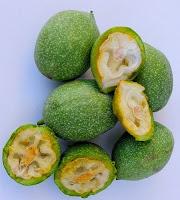On a mid-summer evening a few years ago, I joined a group of Italian friends for dinner. Seven of us gathered around a large kitchen table and feasted on lasagna as the first course—a staple for dinner parties because the cook can prepare the pasta ahead of time with no last minute prep needed. On the terrace, our host barbecued fat sausages, steak, and chicken along with eggplant, zucchini, and red peppers. A sumptuous—and typical—Italian summer feast.
 Afterward, we ate splendid peaches and cherries. When we were sated, out came the espresso and tiny glasses that signaled a digestivo would follow. When our host brought out the bottle, the Italians began muttering, “Oh, Nocino!” and “Did you make it yourselves?” and “Did you gather the noci at San Giovanni?”
Afterward, we ate splendid peaches and cherries. When we were sated, out came the espresso and tiny glasses that signaled a digestivo would follow. When our host brought out the bottle, the Italians began muttering, “Oh, Nocino!” and “Did you make it yourselves?” and “Did you gather the noci at San Giovanni?”When the dense syrup trickled into my glass, everyone gazed at me. They held their breath as I lifted the glass and sipped. My mouth tingled with a hint of cinnamon and cloves. When I swallowed, the flavor of walnuts lingered. The silence evaporated as everyone began talking at once to let me in on the secret. I understood nothing. Finally, order prevailed, and as I continued taking tiny sips, the story emerged.
 An ancient belief held that the dew on the shortest night of the year was a panacea for every illness, especially digestive problems and liver ailments. Traditionally, midsummer was celebrated between June 21 and June 25. In Italy, that became the birthday of St. John the Baptist (June 24). Thus, the dew on the night of June 23 was the most revered.
An ancient belief held that the dew on the shortest night of the year was a panacea for every illness, especially digestive problems and liver ailments. Traditionally, midsummer was celebrated between June 21 and June 25. In Italy, that became the birthday of St. John the Baptist (June 24). Thus, the dew on the night of June 23 was the most revered.Walnuts have always been linked to witches and spells, and the superstition required that the dew on the walnuts be collected by a barefoot virgin to counteract those spells. She was supposed to climb the tree and collect the walnuts without using metal to cut them. The following morning, the liqueur was mixed and set to age until the night before All Saints Day—Halloween—when it was sipped to ward off those witches and spells.
 Today, few barefoot virgins collect the walnuts, but some people enjoy the tradition of making the liqueur. That early in the summer, the green walnuts can be easily cut into quarters. They are placed in a glass jar; flavored with cinnamon sticks, cloves, and lemon peel; sweetened with sugar; and infused with grain alcohol and sometimes a bit of red wine.
Today, few barefoot virgins collect the walnuts, but some people enjoy the tradition of making the liqueur. That early in the summer, the green walnuts can be easily cut into quarters. They are placed in a glass jar; flavored with cinnamon sticks, cloves, and lemon peel; sweetened with sugar; and infused with grain alcohol and sometimes a bit of red wine.Nocino is made commercially in Modena (home of balsamic vinegar) where a group called Ordine del Nocino Modenese promotes the region’s Nocino. So, if you don’t have a walnut tree handy, or a barefoot virgin available to collect the nuts, perhaps you can sample this wonderful after-dinner drink at home anyway.
Today’s post is late, but it coincides with the day for collecting the walnuts, June 23. Changes are coming to Italian Intrigues. Beginning next week, I’ll be posting here every Thursday.My last essay at Novel Adventurers will appear next week as well.
